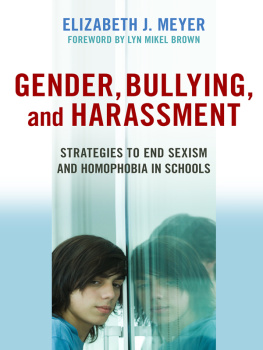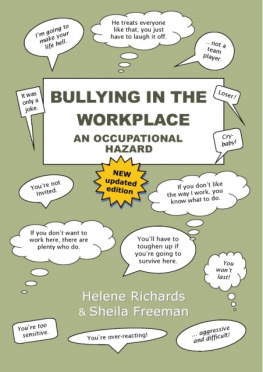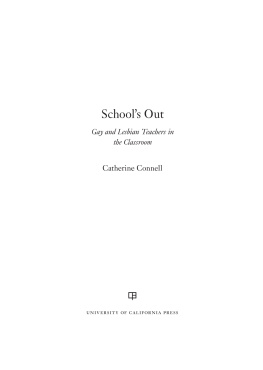Elizabeth J. Meyer - Gender, Bullying, and Harassment: Strategies to End Sexism and Homophobia in Schools
Here you can read online Elizabeth J. Meyer - Gender, Bullying, and Harassment: Strategies to End Sexism and Homophobia in Schools full text of the book (entire story) in english for free. Download pdf and epub, get meaning, cover and reviews about this ebook. year: 2009, publisher: Teachers College Press, genre: Religion. Description of the work, (preface) as well as reviews are available. Best literature library LitArk.com created for fans of good reading and offers a wide selection of genres:
Romance novel
Science fiction
Adventure
Detective
Science
History
Home and family
Prose
Art
Politics
Computer
Non-fiction
Religion
Business
Children
Humor
Choose a favorite category and find really read worthwhile books. Enjoy immersion in the world of imagination, feel the emotions of the characters or learn something new for yourself, make an fascinating discovery.
- Book:Gender, Bullying, and Harassment: Strategies to End Sexism and Homophobia in Schools
- Author:
- Publisher:Teachers College Press
- Genre:
- Year:2009
- Rating:3 / 5
- Favourites:Add to favourites
- Your mark:
- 60
- 1
- 2
- 3
- 4
- 5
Gender, Bullying, and Harassment: Strategies to End Sexism and Homophobia in Schools: summary, description and annotation
We offer to read an annotation, description, summary or preface (depends on what the author of the book "Gender, Bullying, and Harassment: Strategies to End Sexism and Homophobia in Schools" wrote himself). If you haven't found the necessary information about the book — write in the comments, we will try to find it.
Elizabeth J. Meyer: author's other books
Who wrote Gender, Bullying, and Harassment: Strategies to End Sexism and Homophobia in Schools? Find out the surname, the name of the author of the book and a list of all author's works by series.
Gender, Bullying, and Harassment: Strategies to End Sexism and Homophobia in Schools — read online for free the complete book (whole text) full work
Below is the text of the book, divided by pages. System saving the place of the last page read, allows you to conveniently read the book "Gender, Bullying, and Harassment: Strategies to End Sexism and Homophobia in Schools" online for free, without having to search again every time where you left off. Put a bookmark, and you can go to the page where you finished reading at any time.
Font size:
Interval:
Bookmark:

Strategies to End Sexism and Homophobia in Schools
FOREWORD BY
LYN MIKEL BROWN

Teachers College
Columbia University
New York and London
Published by Teachers College Press, 1234 Amsterdam Avenue, New York, NY 10027
Copyright 2009 by Teachers College, Columbia University
All rights reserved. No part of this publication may be reproduced or transmitted in any form or by any means, electronic or mechanical, including photocopy, or any information storage and retrieval system, without permission from the publisher.
Library of Congress Cataloging-in-Publication Data
Meyer, Elizabeth J.
Gender, bullying, and harassment: strategies to end sexism and homophobia in schools / Elizabeth J. Meyer.
p. cm.
Includes bibliographical references and index.
ISBN: 978-0-8077-4953-1 (pbk.: alk. paper) ISBN: 978-0-8077-4954-8 (hardcover: alk. paper) 1. Homophobia in schools--United States. 2. Sexism in educationUnited States. 3. Bullying in schoolsUnited States. 4. School violenceUnited States. I. Title.
LC212.82.M49 2009
371.82664--dc22
2008055598
ISBN: 978-0-8077-4953-1 (paperback)
ISBN: 978-0-8077-4954-8 (hardcover)
e-ISBN: 978-0-8077-7114-3
I found out about the topic of this book through the back door, so to speak. I had been researching relationships between girls, which led me to their friendships, which led me to a study of girlfighting behavior. After analyzing over 400 interviews and focus groups, and with 20 years of listening to, teaching about, and working with girls, I felt I had a pretty good grasp of the reasons why girls betray and hurt one another and how schools can interrupt or unwittingly encourage their behavior. Soon after I finished this research, I was invited to participate in a statewide task force on school climate.
The task force was mostly made up of bully-prevention experts and me. I was struck immediately by the lack of meaningful connection between what I had learned from girls and the literature provided, most of which described bullying within only one paradigm. Bullies were portrayed as impulsive, impudent rule-breakers, who lack compassion, have a strong drive to dominate, and act aggressively toward adults. The girls in my study, on the other hand, thought about their behavior, often expressed regret afterwards, and struggled with their desire for power. Many of them followed the rules and policed the boundaries of gender conformity; adults tended to like them because they appeared civilized and nice. Bullies were also said to be motivated by a strong need for dominance, a hostile attitude to their surroundings, and a need for material and psychological rewards. The girls in my study, however, were often motivated by underlying frustration with unfair treatment and harassment in school, the pressure they felt to match up to media ideals of beauty and perfection, and the promise of visibility and attention from boys. How could a program purported to be a universal intervention for the reduction and prevention of bully/victim problems speak so little to issues relevant to girls aggression?
Not surprising, then, my work with this task force was fraught. I soon discovered that not considering the role of gender is endemic to bully prevention approaches. In meetings I experienced what it felt like to be the problem, the one who didnt get it, who interrupted the flow of progress. My colleagues were good, smart people who listened patiently, but they remained convinced that every assumption I questioned and every absence I noted could be explained away or subsumed under a bully-prevention model.
I started to think that maybe bully prevention had become a bit of a bully itself, threatening to push aside the richly diverse reality of childrens lives for one-size-fits-all trainings, discipline charts, and consistent consequences. If the bullying was to generically stand in for sexism, racism, homophobia, sexual harassment, and even hate crimes, how could we affirm students different experiences not only with one another but also in relation to the rules and structure of their schools? If we dont help students name these differences, how can we educate them about their rights and encourage complex and meaningful solutions to their problems?
I wished I had had this smart, brave book as I struggled to articulate these and other questions. Elizabeth Meyer speaks clearly and sensibly about differences that make a difference in childrens school lives. She distinguishes bullying from various forms of gendered harassment and connects psychological and relational power struggles to the systemic and structural problems that can fuel them. She identifies existing legal protections, such as Title IX, lest we unwittingly undermine them with bully prevention policies that sound inclusive but in reality exclude many, that sound powerful but in practice undermine students rights. At a time when bully prevention has all but taken over the social realities of schools, Elizabeth Meyer encourages us to reconsider our assumptions and challenge what is taken for granted. She reminds us that the best way to ensure student safety is to offer children what we ourselves would wantsomeone willing to set aside simple categories and look beyond the surface of things, someone who will listen carefully and take us seriously.
Lyn Mikel Brown
On February 12, 2008, 15-year-old Larry King was shot in the computer classroom of his California junior high school by another male student after Larry had asked him to be his valentine. Larry was known in his school not only for being openly gay but also for wearing high heels, nail polish, and makeup. This tragic incident is one of the more recent and extreme examples of why it was important to write this book. Educators, parents, and youth need more information and resources about how to address forms of bullying and harassment that are influenced by gender. Gender is an important force in shaping behaviors and informs how we interact with each other and understand ourselves. Unfortunately, the role that gender plays in many incidents of bullying and harassment is often overlooked or accepted as normal, which allows the problem to persist. This book intends to change this trend by providing a new lens for understanding bullying and harassment as well as strategies for ending these phenomena in schools.
As a former high school teacher, I remember how helpless I felt to assist students who turned to me for support in the face of harassment. During my first year of teaching, I had one student come to me on a regular basis to confide in me about all of the taunts and harassment she was enduring. I could see the impact it was having on her health and academic performance, but I didnt know how to help. I offered her individual support but couldnt get other teachers or the administration to address it in a systematic or meaningful way. Everyone seemed to accept sexual harassment and homophobic insults as part of the school culture, and my efforts to work against them were met with extreme resistance and inertia.
In my second teaching job, things werent much better. Gay students were stalked and made fun of, female students were sexually harassed by male peers, and words like fag , bitch , and dyke were commonly used by students to insult and mock their peers. Few of my colleagues or administrators were willing to take clear steps to stop these behaviors. Although I made attempts to engage colleagues in dialogue, worked with the administration to raise their awareness, and attended workshops to expand my understanding of the problem, none of it seemed to have an impact. I was just one classroom teacher, not an expert on the issue. The head of the school told me he would need more time and information before he took any specific actions to address the problem.
Font size:
Interval:
Bookmark:
Similar books «Gender, Bullying, and Harassment: Strategies to End Sexism and Homophobia in Schools»
Look at similar books to Gender, Bullying, and Harassment: Strategies to End Sexism and Homophobia in Schools. We have selected literature similar in name and meaning in the hope of providing readers with more options to find new, interesting, not yet read works.
Discussion, reviews of the book Gender, Bullying, and Harassment: Strategies to End Sexism and Homophobia in Schools and just readers' own opinions. Leave your comments, write what you think about the work, its meaning or the main characters. Specify what exactly you liked and what you didn't like, and why you think so.







